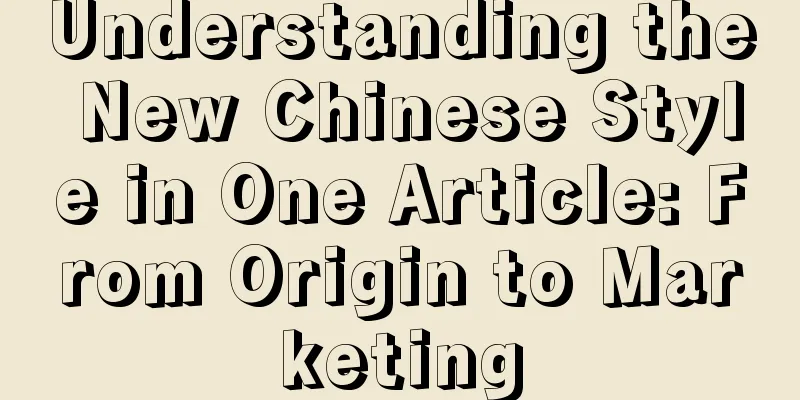Understanding the New Chinese Style in One Article: From Origin to Marketing

In 2024, the New Chinese Style has become one of the most watched business concepts. It has not only attracted enthusiastic pursuit from consumers and hot sales of various commodities, but also become a hot topic in media reports and business analysis. According to Tmall data, the search volume for keywords such as new Chinese style and Hanfu has increased by more than 100% year-on-year in the past two months, and the market size of new Chinese style clothing has reached 1 billion yuan. On JD.com, sales of new Chinese-style clothing increased by 215% year-on-year, and sales of Hanfu products increased by 325% year-on-year. On social networks, discussions about the New Chinese style are growing louder and louder. On Douyin, the topic of "New Chinese Style Dressing" has been played more than 10 billion times in total; the volume of notes related to "New Chinese Style" on the Xiaohongshu platform has increased by more than 390%, and the total amount of interactions has increased by more than 188%, and the number of notes related to "New Chinese Style Dressing" has reached more than 2.1 million. The rise of the new Chinese style reflects consumers' pursuit of personalized and culturally profound products, and reflects people's re-recognition and evaluation of traditional culture, as well as their desire to express it in a new form. How did the trend of New Chinese Style come about? What is its cultural significance and commercial value? How should brands grasp this trend? This article will explore the phenomenon of New Chinese Style in depth, and try to provide some new perspectives and thinking paths for brands and the market. 1. Starting from the rise of Japanese styleThe popularity of the new Chinese style is not only a product of China's rapid economic development, but also a manifestation of cultural confidence. This phenomenon is not isolated. A similar trend has also been a model in Japan - the rise of Japanese style. Exploring the development of Japanese style can provide useful inspiration for understanding the trend of the new Chinese style. Japanese style is the product of Japan's rapid economic recovery and prosperity after World War II, when cultural confidence gradually increased. During this period, Japan became one of the most developed countries in the world, and the economic prosperity provided strong financial and market support for the development of the design and fashion industry. At the same time, the Japanese government's emphasis on and support for design education has cultivated a group of designers and creative talents who have inherited traditional craftsmanship and received education in modern design concepts, injecting new vitality into the development of Japanese style. The Japanese style places particular emphasis on simplicity, nature and functionality, which is highly consistent with the lifestyle pursued by modern urbanites. In design, it pays attention to details and craftsmanship, and emphasizes the nature and texture of materials. This unique understanding and pursuit of aesthetics makes the Japanese style uniquely attractive not only in Japan but also internationally. During this process, a group of design masters emerged, bringing Japanese style onto the global stage. The works of Kenzo Takada, Issey Miyake, Rei Kawakubo and others have attracted widespread attention in the international fashion industry, not only showcasing Japanese aesthetics, but also influencing global fashion trends. Their success has elevated the status of Japanese style, making it an important branch of the global design community. Following the guidance of these masters, a large number of Japanese brands have sprung up like mushrooms after a rain. They have spread the concepts and aesthetics of Japanese style to all parts of the world, making Japanese style popular all over the world. Issey Miyake's brand design combines elements of traditional Japanese clothing with modern fashion tailoring, showing a modern interpretation of Japanese style. Today, it has a strong influence in the world fashion industry. As a brand focusing on home furnishings, KINTO embodies the "minimalism" in Japanese culture with its simple and elegant designs. MUJI, with Kenya Hara as its design director, has a design concept that embodies the "wabi-sabi" aesthetics of Japanese culture and has become a typical representative of Japanese clothing. In summary, the rise of Japanese style is the result of economic prosperity, the emergence of talents, the guidance of masters and the explosion of brands. This process not only demonstrates the profound heritage of Japanese culture, but also reflects the confidence and openness of a country in economy and culture. 2. The predecessor of the new Chinese style - GuochaoAs a direct reflection of China's economic development and national cultural confidence, the concept of New Chinese style is not the first to appear. As early as the beginning of the 21st century, clothing, home furnishings and other fields inspired by Chinese style design were frequently mentioned. This modern interpretation of traditional Chinese aesthetics has gradually formed a unique cultural expression, which is deeply loved by consumers at home and abroad. Against this background, the concept of national trend has experienced an explosion. As the name suggests, Guochao refers to a trendy cultural phenomenon based on Chinese culture and integrating modern design and fashion elements. It is not only reflected in clothing design, but also has a wider impact on home furnishing, digital, beauty and other fields, becoming an all-round cultural and commercial phenomenon. During the period when national trends were popular, many brands achieved remarkable success by virtue of their unique use of national trend elements and market insights. Li Ning, as a representative of Chinese sports brands, has become a symbol of the rise of Chinese fashion by incorporating traditional Chinese cultural elements into product design and displaying them at international fashion weeks, especially at the New York Fashion Week in 2018. Li Ning's "Wudao" series is not only popular in the domestic market, but also has won wide attention and recognition internationally. Warrior, a shoe brand with nearly a century of history, has transformed itself into a national fashion brand through repackaging and adjustment of marketing strategies. Warrior shoes, with their classic design and retro style, quickly became popular among young consumers and became an important symbol of national fashion culture. The Palace Museum's cultural and creative products are a model of combining traditional Chinese culture with modern creative design. By launching a series of creative cultural and creative products, such as the Palace Museum lipstick and the Palace Museum calendar, the Palace Museum's cultural and creative products not only give new vitality to traditional culture, but also become a highlight in the national trend market. Brands such as Huaxizi, Perfect Diary, and Chando also launched related products during the period when the national trend was popular, becoming a symbol of the rise of the national trend around 2018. 3. The rise and characteristics of the new Chinese styleThe emergence of the new Chinese style does not have a clear time node, but is a gradual, natural evolution process. During this period, the Dior incident was undoubtedly an important accelerator. In July 2022, Dior released a mid-length skirt that was highly similar to the traditional Chinese dress, the horse-faced skirt, which sparked heated discussions on social media. The public expressed strong dissatisfaction with Dior's behavior, believing that the brand lacked respect for Chinese culture. This incident not only brought the traditional dress of the horse-faced skirt into the public eye, but also became the focus of attention in the fashion industry. Later, in Paris, France, about 50 Chinese people and international students dressed in Hanfu held a protest in front of the Dior flagship store, strongly calling on Dior to stop "cultural appropriation" and apologize. This incident not only brought the horse-faced skirt, a traditional Chinese costume, into the public eye, but also became an opportunity for the new Chinese style to reach a wider audience. Since then, the new Chinese style has begun to be recognized by the fashion industry and consumers, and designers and brands have begun to explore how to combine traditional Chinese cultural elements with modern aesthetics. Around the Spring Festival in 2024, e-commerce manufacturers in Cao County began to mass-produce horse-faced skirts. This action was based on a keen insight into market demand. Due to its obvious price advantage and high-quality products, Cao County's horse-faced skirts quickly occupied the market share, and its sales quickly exceeded 300 million yuan. This achievement not only demonstrates the market potential of the new Chinese style, but also proves Cao County's leading position in the Hanfu industry, especially in the production of horse-faced skirts. Since then, the new Chinese style has been widely discussed and gradually became a cultural phenomenon and market trend. In this process, some brands that have been committed to the Chinese style for many years have become representatives of the new Chinese style by virtue of their deep understanding and ingenious application of the concept of the new Chinese style, and they have also begun to be noticed by the market. For example, the representative brand of new Chinese-style furniture, Xiongye Benmu Shangzao, and new Chinese-style clothing brands such as Gaia Legend and Mishan are beginning to be noticed and purchased by more and more consumers. The new Chinese style has the following characteristics: 1. Modern interpretation of elementsThe most notable feature of the new Chinese style is the combination of traditional Chinese cultural elements, such as calligraphy, painting, symbols and patterns in classical literature, and traditional craftsmanship, with modern design concepts and fashion elements. For example, Mishan is famous for its modern interpretation of traditional fan culture, incorporating the shape and pattern of fans into clothing design to create clothing that is both classical and modern. 2. Combination of functionality and comfortThe new Chinese style not only focuses on the aesthetics of the appearance, but also emphasizes the practicality and comfort of the product. While maintaining the traditional style, designers will take into account the living habits and needs of modern people to make the product both beautiful and practical. 3. Transmission of cultural connotationsThe new Chinese style is not only a visual style, but also a cultural transmission and expression. It conveys the connotation and values of traditional Chinese culture to consumers through design. For example, the Forbidden City's cultural and creative products integrate the Forbidden City's cultural elements into daily necessities, allowing consumers to feel the charm of traditional Chinese culture during use. Although the New Chinese style is a Chinese trend that follows the national trend, the two are not the same. The following are the differences between the two. 4. How can brand marketing take advantage of the new Chinese style? As a self-media focusing on the field of marketing, the last part of this article will explain how brand marketing should be grasped in the face of the new Chinese trend. 1. Explore cultural connotations and tell good brand storiesIn the new Chinese marketing wave, one of the keys to a brand's success is to deeply explore and effectively utilize China's rich cultural connotations. By finding cultural elements that match the brand spirit, brands can not only enhance the cultural value of their products, but also deepen their emotional connection with consumers and build a unique brand story. Although Suntory Oolong Tea is a Japanese brand, it has always emphasized that its products are authentic Chinese oolong tea. Through advertising and marketing activities, it conveys a peaceful and harmonious lifestyle related to tea culture. In this respect, Suntory can be said to be one of the earliest brands to engage in Chinese-style marketing. In Suntory Oolong Tea's early advertisements, the brand used characters from traditional Chinese paintings as the main elements of the posters. This intuitive cultural symbol allows customers to immediately feel the long history of tea culture and the tea-drinking aesthetics of traditional literati, thereby establishing a close connection between the brand and traditional Chinese tea culture in the minds of consumers. As more and more people come to know that "Suntory Oolong Tea is an authentic Chinese tea with a long history", the brand has begun to explore Chinese cultural symbols more deeply. In a series of advertisements, Suntory extracted explicit "Chinese symbols" such as Beijing crosstalk, Chinese dance, and Chinese Kung Fu, and filmed them in various places in China such as the fields of Guilin and Wuyi Mountain in Fujian, deepening the "regional" impression of the products. 2. Innovative product designUnder the guidance of the new Chinese style, the brand takes advantage of the opportunity to launch new Chinese products with Chinese cultural heritage, which not only demonstrates the cultural depth of the products, but also brings unique market competitiveness and high recognition from consumers to the brand. The Palace Museum successfully combined hundreds of years of brand connotations with modern consumer goods and launched the Palace Museum lipstick, which almost immediately sparked a market boom. The Forbidden City lipstick incorporates the cultural symbols and artistic aesthetics of the Forbidden City, such as using the Forbidden City’s colors and patterns to design the packaging, making this lipstick a model of the combination of inherited culture and modern aesthetics. Once the product was launched, it was quickly sold out due to its unique cultural value and aesthetic design, demonstrating the profound cultural charm and market appeal of new Chinese-style products. The "Peach Pink New Year" new Chinese style series launched by MO&Co. in 2024 also demonstrates the innovation and appeal of new Chinese style product design. The series occupies a prominent position on the homepage of the Tmall flagship store and is specially displayed in offline stores. The product is made of mulberry silk fabric and incorporates traditional elements such as peach blossoms and bamboo into the design, conveying the beautiful image of spring flowers blooming. The new Chinese style products also pushed up the price of MO&Co. to around 2,000 yuan. For brands whose products are difficult to directly integrate with the new Chinese style, innovative packaging design can also become a highlight to attract consumers. For example, Gu Ming’s DIY calligraphy works on blank cups allow consumers to create freely on the cups. This interactive and personalized experience has been widely praised on social media. Gu Ming also cooperated with Douyin to launch the Yunwu Gardenia Green Calligraphy Cup. This new product combines calligraphy art with modern drinks through its unique packaging design, demonstrating the innovation of new Chinese design and the depth of brand culture. 4. Cooperation and joint brandingThe rise of the new Chinese style provides new opportunities for brand marketing, especially through cooperation and joint ventures with IPs or other brands with new Chinese cultural heritage. This strategy can not only enrich the brand personality, but also enhance the emotional resonance with consumers, thereby improving the brand's market competitiveness and consumer loyalty. The joint cooperation between Bawang Cha Ji and the Guangdong Jieyang intangible cultural heritage "Fireworks and Fire Dragon" is an example of integrating traditional festival culture into modern consumer products. Fireworks and Fire Dragon is a traditional art in Guangdong with strong local characteristics and cultural connotations. Through this collaboration, Bawang Cha Ji launched a series of packaging and peripheral products. This collaboration not only rekindled the public's interest in and respect for traditional festival culture, but also made this culture more relevant to the lifestyles of modern consumers through modern product forms. Nayuki has teamed up with "Forbidden City Patterns" to launch a joint product of incense and fireworks. By adopting Forbidden City elements such as "Rising Dragon Pattern" and "Ruyi Cloud Pattern", Nayuki's products not only give people a visual enjoyment, but also resonate with consumers emotionally. Through co-branded products, consumers can not only enjoy delicious food, but also get in touch with and learn about traditional Chinese art. The integration of this culture has significantly enhanced the brand's cultural value and market appeal, while also making Nayuki's brand image more profound and diverse. V. ConclusionThe emergence and popularity of the new Chinese style is essentially a natural result of economic prosperity and cultural confidence. This phenomenon is similar to Japanese style, which has long demonstrated on the international stage how to integrate traditional culture into modern design, becoming a cultural and fashion trend that is welcomed worldwide. From the initial attempts at Chinese style to the widespread popularity of national trends, and then to the popularity of new Chinese style, we have witnessed how Chinese concepts are gradually integrated into and lead mainstream cultural trends. This process not only demonstrates the unique charm of traditional Chinese aesthetics, but also reflects Chinese society's re-evaluation of and confident expression of its local culture. For brands, the new Chinese style is not only a trend, but also an opportunity. Brands can tap into China's rich cultural resources and combine them with modern design concepts to launch products and services with Chinese characteristics, which can not only meet the needs of domestic consumers for cultural identity, but also attract the interest of global consumers. Through innovative product design, strategic collaborations and co-branding, as well as smart market positioning, brands are able to take advantage of the new Chinese style and stand out in a highly competitive market. Author: Xunkong Source: WeChat public account "Xunkong's Marketing Revelation (ID: xunkong2005)" |
<<: Data analysis question: Would you buy a Xiaomi car?
>>: Can “Liu Qiangdong” support JD Live as a host?
Recommend
The card game craze of the post-2010s: addiction, comparison and social interaction
Recently on TikTok, live broadcasts of “unpacking ...
What are the delivery procedures on the Wish platform? What are the methods?
The most important thing for everyone doing cross-...
How about opening a store on eBay? Does anyone still use it?
When it comes to cross-border e-commerce platforms...
How do Shopee merchants bind their payment accounts? How can they modify the accounts?
In order to ensure that Shopee merchants receive p...
New regulations on public account advertising have been implemented, account owners should stay calm!
WeChat has added new advertising rules for public ...
How should marketers formulate plans for the whole year of 2023?
Annual planning is something that relevant personn...
How to solve the problem of repeated registration on Shopee? What to do if registration fails?
Today, I will introduce the content of Shopee'...
Is it easy to make customized products on Amazon? Which products are easy to sell on Amazon?
Some merchants on Amazon provide customized produc...
Xiaohongshu AIPS crowd asset model (the latest and most complete practical analysis)
In the era of digital marketing, how can brands ac...
How to ship goods without a source? Five steps
Many merchants doing cross-border e-commerce on Wi...
Luckin Coffee’s way of survival: “speed” is the only way to survive
This article starts from the three aspects of Luck...
These merchants who "listened to the advice" all started to make things because they saw two great potentials.
This article deeply analyzes the business strategi...
What is an Amazon Associate Account? What are the advantages?
Many friends are doing Amazon now. When doing Amaz...
What should I do if I can’t get through to Amazon’s customer service? How can I handle Amazon’s after-sales issues?
Amazon is an e-commerce platform covering the whol...
Is Wish children's clothing easy to sell? How can I make it sell well?
Every family is willing to spend money on their ch...









